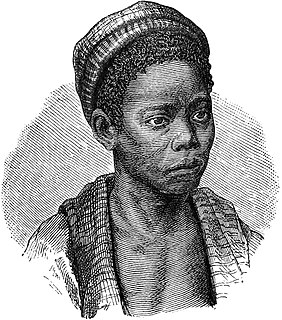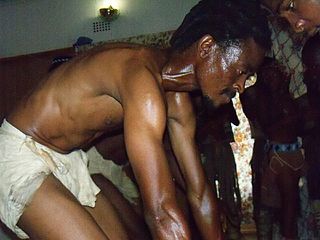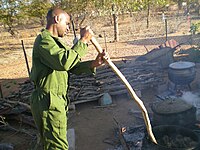
Barbecue or barbeque is a term used with significant regional and national variations to describe various cooking methods which use live fire and smoke to cook the food. The term is also generally applied to the devices associated with those methods, the broader cuisines that these methods produce, and the meals or gatherings at which this style of food is cooked and served. The cooking methods associated with barbecuing vary significantly but most involve outdoor cooking.

The Tswana are a Bantu-speaking ethnic group who are native to Southern Africa. The Tswana language is a principal member of the Sotho-Tswana language group. Ethnic Tswana made up approximately 85% of the population of Botswana in 2011.

Mămăligă is a porridge made out of yellow maize flour, traditional in Romania, Moldova and West Ukraine. Preparing the traditional dish is also continued by Poles from Lviv whose families were resettled in the Recovered Territories after World War II. In Italy, Portugal, Switzerland, Slovenia, Croatia and many other countries, this dish is known as polenta, while in Georgia, it is called ღომი (gomi).

Kebab is a cooked meat dish, with its origins in Middle Eastern cuisines. Many variants are popular around the world.

Aspic is a savoury gelatin made with a meat stock or broth, set in a mold to encase other ingredients. These often include pieces of meat, seafood, vegetable, or eggs. Aspic is also sometimes referred to as aspic gelée or aspic jelly. Aspic is essentially a gelatinous version of conventional soup.

A tajine or tagine is a North African dish, named after the earthenware pot in which it is cooked. It is also called maraq or marqa.

A fritter is a portion of meat, seafood, fruit, vegetables or other ingredients which have been battered or breaded, or just a portion of dough without further ingredients, that is deep-fried. Fritters are prepared in both sweet and savory varieties.
Traditionally, the various cuisines of Africa use a combination of plant and seed based, and do not usually have food imported. In some parts of the continent, the traditional diet features an abundance of root tuber products.

Ugali, or nsima, is a type of stiff maize flour porridge made in Africa. It is also known as vuswa, bogobe, fufu, gauli, gima, isitshwala, kimnyet, kuon, mieliepap, ngima, nshima, obokima, obuchima, obusuma, oshifima, oruhere, pap, phutu, posho, sadza, ubugali, and umutsima, among other names. Nsima is sometimes made from other flours, such as millet or sorghum flour, and is sometimes mixed with cassava flour. It is cooked in boiling water or milk until it reaches a stiff or firm dough-like consistency. In 2017, the dish was added to the UNESCO Representative List of the Intangible Cultural Heritage of Humanity, one of a few foods in the list.

Oxtail is the culinary name for the tail of cattle. While the word once meant only the tail of an ox, today it can also refer to the tails of other cattle. An oxtail typically weighs 7–8 lb (3.2–3.6 kg) and is skinned and cut into short lengths for sale.

The cuisine of Botswana is unique but shares some characteristics with other cuisines of Southern Africa. Examples of Setswana food include pap, samp, vetkoek, bogobe and mophane worms. A food unique to Botswana is seswaa, salted mashed-up meat.

Bobotie is a well-known South African dish consisting of spiced minced meat baked with an egg-based topping.

Goat meat or goat's meat is the meat of the domestic goat (Capra aegagrus hircus). The common name for goat meat is simply "goat", though meat from adult goats is referred to as chevon, while that from young goats can be called capretto (It.), cabrito (Sp.) or kid. In South Asian and Caribbean cuisine, mutton commonly means goat meat. In South Asia, where mutton curry is popular, "mutton" is used for both goat and lamb meat.

Acheke, also spelled attiéké or akyeke (Ghana), is a side dish made from cassava, and is a popular and traditional cuisine in West Africa. The dish is prepared from fermented cassava pulp that has been grated or granulated. Dried attiéké is also prepared, which is similar in texture to couscous.

Tsutsube is a traditional dance and accompanying music in Botswana which is practiced by Basarwa or San people. Tsutsube is performed in four ritualistic categories or stages which are the first kill, puberty, marriage and trance. According to the history, the first kill was for males or boys, and trance dance was for healing purposes to engage ancestors spirits.
















